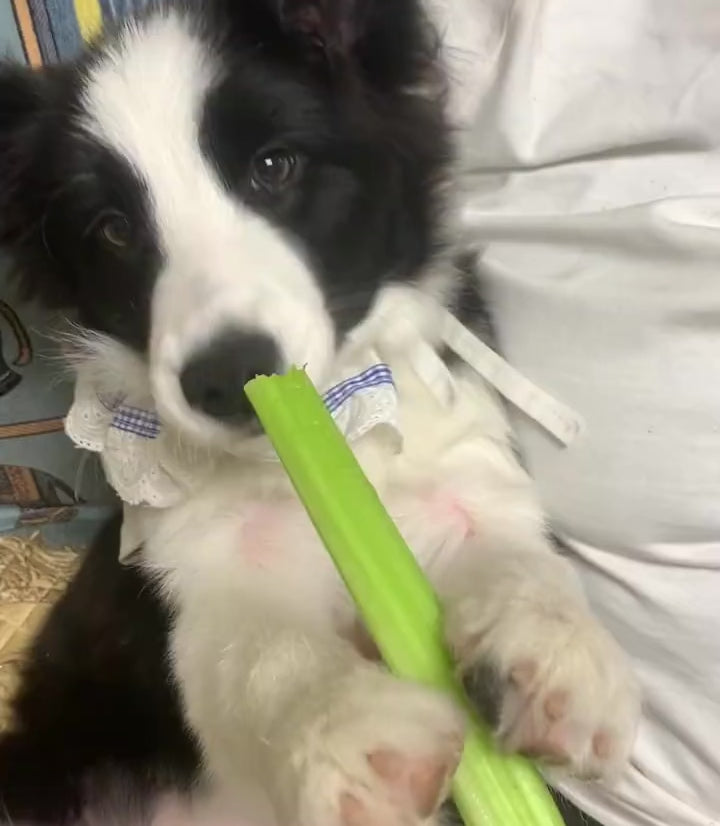1.Conclusion (Quick Answer)
(1) First, let's talk about the conclusion:
Can dogs eat celery? Yes, dogs can safely eat celery in moderation, as it’s a non-toxic vegetable that provides essential nutrients like vitamins A, C, and K, along with potassium, antioxidants, and dietary fiber. The high fiber content in celery can support healthy digestion and help regulate bowel movements. Celery is also low in calories and high in water content, making it a healthy treat for dogs when prepared properly.
(2)Recommended Dosage:
The ideal amount of celery depends on your dog’s size (always start with a smaller portion, such as half the recommended amount, to ensure your dog tolerates it well):
- Small dogs (under 20 pounds, e.g., Chihuahuas, Dachshunds):
1–2 small celery pieces per meal (approximately 3–5 cm long and 1 cm wide), 2–3 times per week. - Medium dogs (20–50 pounds, e.g., Beagles, Cocker Spaniels):
2–3 small celery pieces per meal (approximately 5–7 cm long and 1–1.5 cm wide), 2–3 times per week. - Large dogs (over 50 pounds, e.g., Labradors, German Shepherds):
3–4 small celery pieces per meal (approximately 7–10 cm long and 1.5–2 cm wide), 2–3 times per week.
(3)When and How to Serve:
Preparation:
- Wash Thoroughly: Rinse celery under clean water to remove any dirt or pesticides.
- Remove Leaves: Celery leaves may be harder to digest, so it’s best to remove them before serving.
- Raw or Lightly Steamed: Celery can be served raw for added crunch or lightly steamed to soften it, making it easier for dogs to chew and digest.
Serving Options:
- Mixed with Food: Combine celery with your dog’s regular meals, such as mixing it into their kibble or wet food, to balance the flavor and texture.
- Stand-Alone Treat: Offer celery as a crunchy, low-calorie snack between meals.
(4)Important Considerations:
Taste Preference: Not all dogs enjoy the flavor or texture of celery. Forcing celery into their diet may lead to food aversion or rejection of their regular meals.
Organic and Washed Celery: Non-organic celery may contain pesticides or harmful residues. Always wash celery thoroughly before feeding and consider using organic options when possible.
Nutritional Balance: While celery is healthy, it should not replace your dog’s main meals or essential nutrients. Use it as an occasional treat or supplement, not as a staple food.
2. Personal Experience: My Dogs and Celery

My friend has a dog who absolutely loves celery as a treat. Over the years, celery has become a regular part of his snacks. Now at eight years old, he remains in excellent health and has never experienced any gastrointestinal issues. My friend believes that the high fiber content in celery and its overall nutritional benefits may have contributed to his dog’s strong digestive system.
After consulting with many dog owners, I spoke to about twenty people who regularly feed celery to their pets. Based on their feedback, I reached the following conclusion: celery rarely causes any adverse reactions in dogs. In fact, many owners noticed that celery seems to improve their pets' digestive function to some extent.
3.Benefits of Celery for Dogs
Many people wonder, Can dogs eat celery? However, most people don’t realize that celery offers numerous benefits for dogs.
(1) Rich in Nutrients:
- Vitamins A, C, and K: Promote healthy vision, support immune system function, and strengthen bones.
- Potassium: Supports proper muscle and nerve function.
- Fiber: Aids digestion and promotes healthy bowel movements.
(2) Low-Calorie Treat:
- Celery is low in calories and fat, making it an excellent snack for overweight dogs or those needing weight control.
- Provides a satisfying crunch without adding unnecessary calories.
(3) Hydration:
- High water content helps keep your dog hydrated, especially on hot days or after physical activity.
- Supports overall kidney health.
(4) Antioxidant Properties:
- Contains antioxidants that protect cells from damage caused by free radicals.
- Helps reduce inflammation and supports long-term immune health.
(5) Dental Health:
- The crunchy texture of celery can naturally clean teeth and help freshen breath.
- Supports overall oral hygiene by reducing plaque buildup.


4.Risks of Feeding Celery to Dogs
(3) Choking Hazard: Celery is stringy and can pose a choking risk, especially for smaller dogs or those that eat quickly. Always chop celery into bite-sized pieces appropriate for your dog’s size.
(4) Pesticides and Contaminants: Non-organic celery may carry pesticides or harmful residues that can be toxic to dogs. Thoroughly wash celery before feeding and consider organic options to minimize risks.
5. How to Feed Shrimp to Dogs
(1) Start Small:
- When introducing celery to your dog’s diet for the first time, start with a very small portion to see how they react.
- Begin with one small piece of celery (about 3–5 cm long), properly chopped, and monitor their tolerance.
(2) Wash Thoroughly:
- Always wash celery thoroughly under clean water to remove dirt, pesticides, or other harmful residues before feeding it to your dog.
(3) Cut Into Small Pieces:
- Chop celery into bite-sized pieces based on your dog’s size to prevent choking hazards.
- Small dogs: 3–5 cm pieces.
- Medium dogs: 5–7 cm pieces.
- Large dogs: 7–10 cm pieces.
(4) Mix with Regular Food:
- The best way to serve celery is to mix it into your dog’s regular meal to balance the flavor and make it easier to consume.
(5) Important Notes:
- Always monitor your dog for any adverse reactions, such as vomiting, diarrhea, or itching, when introducing celery for the first time.
- Remember, celery is a treat and should not replace essential nutrients or a balanced diet. It should complement your dog’s regular meals.
6. Conclusion
(1) Celery is safe for dogs to eat in moderation and can be a healthy addition to their diet. This nutritious vegetable provides essential vitamins like A, C, and K, along with minerals such as potassium and antioxidants. Celery is low in calories and fat, high in fiber and water content, and supports digestion, hydration, and overall health. However, it’s important to wash celery thoroughly, chop it into small, bite-sized pieces, and introduce it gradually in appropriate portions based on your dog’s size.
(2) In summary, celery can be a nutritious and crunchy addition to your dog’s meals when fed responsibly, allowing them to enjoy its health benefits while staying safe and healthy.


Share: